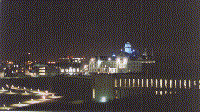- HREF Hypertext REFerence. Tells the browser that this is a link.
- NAME Defines the name of a location within a document. This is then used by a HREF tag to jump to a specific location within a document. The location in the document that you want to reference must have a NAME tag. The syntax for this tag is:
<A NAME="beginning">
- http://
- Chemistry 146 This is a link to a document on a web server. For standard usage the link should be descriptive. Avoid saying "click here", the link is highlighted by the browser and it is obvious where to click.
- ftp://
- Acid Spreadsheet (*.wk4 155k) This is a link to a file on an FTP server. *.wk4 in the name is a clue that this is a Lotus spreadsheet. The 155k is the file size. (this is good form so someone with a modem does not try to download a 10 MB file.)
- mailto://
- svanbram@science.widener.edu This link sends an e-mail message using the mail software for the browser. Note: The student labs at Widener are not configured with mail, so do not expect students to use this link in the lab.
The address may also specify a location in the document to go to. This location must be defined with a NAME tag (detailed above). There is a name tag at the top of this document and you may use link to go to the beginning of the page. Elements of this tag include:
For the address "#beginning". The # tells the browser that this is a location in the document. This location does not have to be within the current document.
The example show below will jump do a section named "links" in the document "testdoc.html" on the server "science.widener.edu" in the file directory "svb/htmltalk". Examples of links The link may also be formatted like this: Examples of links. The HTML code for these two examples is shown below:
<A HREF="http://science.widener.edu/svb/htmltalk/testdoc.html#links">Examples of links</A>
<A HREF="http://science.widener.edu/svb/htmltalk/testdoc.html" NAME="links">Examples of links.</A>
Figures
Most browsers can view two different types of graphics files. These two different file types have different strengths and weaknesses. The figures may be located at any location on the web, you just have to create a link to the file. Keep in mind that graphics files may be very large. This causes very slow downloads that may try a reader's patience.Graphics files may be found by searching the web. A number of large libraries are available. You may also use clipart, drawing programs, or a scanner to create files.
GIF (Graphical Image Format). This format works best for line art and small images. The image below is created with the following HTML code:

JPEG (Joint Photographic Experts Group). This format works best for photographs and color images. Some resolution is lost for line art (lines are not a crisp).

Because images files are very large it is not "good form" to place a large image in a document. A common solution is to use a small "thumbnail" of the image that loads quickly and gives the viewer some idea what the image is. This is linked to the full size figure for interested viewers. Notice the blue border around the image below. This shows that it is a link. THE HTML for this link is:

Tables
Tables are a useful feature for formatting information. These are a bit tricky to set up but with the table builder in Webedit it is easy to get started. The major tags include:
- <TABLE WIDTH=60% ALIGN=center BORDER></TABLE>
- The tags to define the beginning table, the width, the alignment, the border, and the end of the table.
- <CAPTION ALIGN=top></CAPTION>
- The table caption
- <TR></TR>
- A single row of the table.
- <TH></TH>
- A single element (cell) of the table that is a header for a column or row. This element is usually displayed with a bold font and centered in the cell.
- <TD></TD>
- A single data element (cell) of the table.
| Top Col 1 | Top Col 2 | Top Col 3 |
|---|---|---|
| data 1a | data 2a | data 3a |
| data 1b | data 2b | data 3b |
| data 1c | data 2c | data 3c |
Counter and usage statistics
- You may add a counter to your web page by inserting the following code. Replace "USERID" with your login ID (i.e. sev0001)
<img src="/cgi-bin/Count.cgi?df=USERID.dat"> - Statistics about web page usage are available for Muse at: http://muse.widener.edu/stats
Controling access
This feature is under development.Maintenance
I highly recommend that you periodically browse through your web pages to find any old links that are no longer valid. There are software programs that will automate this process. I use a program called LinkBot.This document was prepared by
Scott Van Bramer
Widener University
Department of Chemistry
svanbram@science.widener.edu
Last Updated 5/20/98